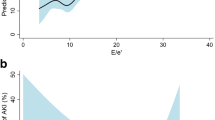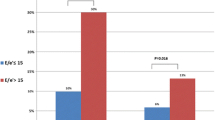Abstract
Assessment of left ventricular (LV) diastolic dysfunction is important in patients with chronic kidney disease (CKD). The early diastolic peak intraventricular pressure gradient (IVPG) has a vital role in diastolic function. Relative pressure imaging (RPI) is a new echocardiographic method to quantify IVPG. The purpose of this study was to analyze RPI-derived IVPG in advanced CKD patients with preserved LV ejection fraction. The study population consisted of 51 advanced CKD patients and 39 healthy controls. Patients were stratified by the evidence of heart failure with preserved ejection fraction (HFpEF) into HFpEF group (32 patients) and non-HFpEF group (19 patients). RPI analysis was used to determine the early diastolic LV relative pressure and pressure distribution. The total IVPG and segmental IVPGs corresponding to basal, mid, and apical part of the LV were calculated. Total IVPG, along with apical and mid IVPGs were all significantly reduced in HFpEF Group compared with non-HFpEF Group and controls (all P < 0.05). But no significant difference of total or segmental IVPGs was found between non-HFpEF Group and the controls. Additionally, apical IVPG < 0.02 mmHg/cm (Hazard ratio 9.82, 95 % confidence interval 2.01−48.01, P = 0.005) was the independent risk factor for the composite outcome (mortality and cardiovascular hospitalization) during a median follow-up of 24 months. Advanced CKD patients with HFpEF exhibited decreased apical and mid IVPG of the LV, and the severity of apical IVPG reduction correlated with poor outcome.





Similar content being viewed by others
Availability of data and material
All data generated and analyzed in this study is available from the corresponding author on reasonable request.
References
Gansevoort RT, Correa-Rotter R, Hemmelgarn BR, Jafar TH, Heerspink HJL, Mann JF et al (2013) Chronic kidney disease and cardiovascular risk: epidemiology, mechanisms, and prevention. Lancet 382:339–352
Zoccali C, Benedetto FA, Mallamaci F, Tripepi G, Giacone G, Cataliotti A et al (2004) Prognostic value of echocardiographic indicators of left ventricular systolic function in asymptomatic dialysis patients. J Am Soc Nephrol 15:1029–1037
Yamada S, Ishii H, Takahashi H, Aoyama T, Morita Y, Kasuga H et al (2010) Prognostic value of reduced left ventricular ejection fraction at start of hemodialysis therapy on cardiovascular and all-cause mortality in end-stage renal disease patients. Clin J Am Soc Nephrol 5:1793–1798
Ahmed A, Rich MW, Sanders PW, Perry GJ, Bakris GL, Zile MR et al (2007) Chronic kidney disease associated mortality in diastolic versus systolic heart failure: a propensity matched study. Am J Cardiol 99:393–398
Sato K, Grant AD, Negishi K, Cremer PC, Negishi T, Kumar A et al (2017) Reliability of updated left ventricular diastolic function recommendations in predicting elevated left ventricular filling pressure and prognosis. Am Heart J 189:28–39
Berlot B, Mur JLM, Jug B, Muñoz DR, Megias A, Rojo EC et al (2019) Effect of diastolic dysfunction on intraventricular velocity behavior in early diastole by flow mapping. Int J Cardiovasc Imaging 35:1627–1636
Firstenberg MS, Smedira NG, Greenberg NL, Prior DL, McCarthy PM, Garcia MJ et al (2001) Relationship between early diastolic intraventricular pressure gradients, an index of elastic recoil, and improvements in systolic and diastolic function. Circulation 104:I330–I335
Londono-Hoyos FJ, Swillens A, Van Cauwenberge J, Meyers B, Koppula MR, Vlachos P et al (2018) Assessment of methodologies to calculate intraventricular pressure differences in computational models and patients. Med Biol Eng Comput 56:469–481
Pedrizzetti G, La Canna G, Alfieri O, Tonti G (2014) The vortex―an early predictor of cardiovascular outcome? Nat Rev Cardiol 11:545–553
Tanaka T, Okada T, Nishiyama T, Seki Y (2017) Relative pressure imaging in left ventricle using ultrasonic vector flow mapping. Jpn J Appl Phys 56:07JF26
Ponikowski P, Voors AA, Anker SD, Bueno H, Cleland JG, Coats AJ et al (2016) 2016 ESC Guidelines for the diagnosis and treatment of acute and chronic heart failure. Eur J Heart Fail 18:891–975
Lang RM, Badano LP, Mor-Avi V, Afilalo J, Armstrong A, Ernande L et al (2015) Recommendations for cardiac chamber quantification by echocardiography in adults: an update from the American Society of Echocardiography and the European Association of Cardiovascular Imaging. J Am Soc Echocardiogr 28:1–39
Nagueh SF, Smiseth OA, Appleton CP, Byrd BF, Dokainish H, Edvardsen T et al (2016) Recommendations for the evaluation of left ventricular diastolic function by echocardiography: an update from the American Society of Echocardiography and the European Association of Cardiovascular Imaging. J Am Soc Echocardiogr 29:277–314
Antlanger M, Aschauer S, Kopecky C, Hecking M, Kovarik JJ, Werzowa J et al (2017) Heart failure with preserved and reduced ejection fraction in hemodialysis patients: prevalence, disease prediction and prognosis. Kidney Blood Press Res 42:165–176
Pitt B, Pfeffer MA, Assmann SF, Boineau R, Anand IS, Claggett B et al (2014) Spironolactone for heart failure with preserved ejection fraction. N Engl J Med 370:1383–1392
Mitter SS, Shah SJ, Thomas JD (2017) A test in context: E/A and E/e’ to assess diastolic dysfunction and LV filling pressure. J Am Coll Cardiol 69:1451–1464
Rovner A, de las Fuentes L, Waggoner AD, Memon N, Chohan R, Dávila-Román VG (2006) Characterization of left ventricular diastolic function in hypertension by use of Doppler tissue imaging and color M-mode techniques. J Am Soc Echocardiogr 19:872–879
Ohara T, Niebel CL, Stewart KC, Charonko JJ, Pu M, Vlachos PP et al (2012) Loss of adrenergic augmentation of diastolic intra-LV pressure difference in patients with diastolic dysfunction: evaluation by color M-mode echocardiography. JACC Cardiovasc Imaging 5:861–870
Iwano H, Kamimura D, Fox E, Hall M, Vlachos P, Little WC (2015) Altered spatial distribution of the diastolic left ventricular pressure difference in heart failure. J Am Soc Echocardiogr 28:597–605
Shigemitsu S, Takahashi K, Yazaki K, Kobayashi M, Yamada M, Akimoto K et al (2019) New insight into the intraventricular pressure gradient as a sensitive indicator of diastolic cardiac dysfunction in patients with childhood cancer after anthracycline therapy. Heart Vessels 34:992–1001
Kobayashi M, Takahashi K, Yamada M, Yazaki K, Matsui K, Tanaka N et al (2017) Assessment of early diastolic intraventricular pressure gradient in the left ventricle among patients with repaired tetralogy of Fallot. Heart Vessels 32:1364–1374
Park M, Hsu CY, Li Y, Mishra RK, Keane M, Rosas SE et al (2012) Associations between kidney function and subclinical cardiac abnormalities in CKD. J Am Soc Nephrol 23:1725–1734
Kitpipatkun P, Matsuura K, Shimada K, Uemura A, Goya S, Yoshida T et al (2020) Key factors of diastolic dysfunction and abnormal left ventricular relaxation in diabetic rats. J Med Ultrason 47:347–356
Yu CM, Sanderson JE, Marwick TH, Oh JK (2007) Tissue Doppler imaging: a new prognosticator for cardiovascular diseases. J Am Coll Cardiol 49:1903–1914
Nauta JF, Hummel YM, van der Meer P, Lam CS, Voors AA, van Melle JP (2018) Correlation with invasive left ventricular filling pressures and prognostic relevance of the echocardiographic diastolic parameters used in the 2016 ESC heart failure guidelines and in the 2016 ASE/EACVI recommendations: a systematic review in patients with heart failure with preserved ejection fraction. Eur J Heart Fail 20:1303–1311
Shah SJ, Katz DH, Selvaraj S, Burke MA, Yancy CW, Gheorghiade M et al (2015) Phenomapping for novel classification of heart failure with preserved ejection fraction. Circulation 131:269–279
Sengupta PP, Pedrizzetti G, Kilner PJ, Kheradvar A, Ebbers T, Tonti G et al (2012) Emerging trends in CV flow visualization. JACC Cardiovasc Imaging 5:305–316
Matsuura K, Shiraishi K, Sato K, Shimada K, Goya S, Uemura A et al (2019) Left ventricular vortex and intraventricular pressure difference in dogs under various loading conditions. Am J Physiol Heart Circ Physiol 316:H882–H888
Acknowledgements
This study was supported by Post-Doctor Research Project, West China Hospital, Sichuan University (No. 19HXBH042), 1·3·5 project for disciplines of excellence-Clinical Research Incubation Project, West China Hospital, Sichuan University (No. 2020HXFH044), and Science & Technology Pillar Program of Sichuan Province (No. 2021YFS0333).
Funding
This study was supported by Post-Doctor Research Project, West China Hospital, Sichuan University (No. 19HXBH042), 1·3·5 project for disciplines of excellence-Clinical Research Incubation Project, West China Hospital, Sichuan University (No. 2020HXFH044), and Science & Technology Pillar Program of Sichuan Province (No. 2021YFS0333).
Author information
Authors and Affiliations
Contributions
YZ drafted the manuscript. YZ, YC, ML and FW enrolled the participants and conducted the data analyses. WB and HT checked the analysis results. LR conceived the study design, revised the manuscript and performed the final approval of the version to be submitted. All authors reviewed the manuscript and gave their consents for publication.
Corresponding author
Ethics declarations
Conflict of interest
The authors declare no competing interests.
Ethical approval
The study protocol was approved by the Institutional Ethics Committee of West China Hospital of Sichuan University (Sichuan, China) for Medical Research, and performed according to the principles of the Declaration of Helsinki. All participants provided their written informed consents.
Additional information
Publisher’s Note
Springer Nature remains neutral with regard to jurisdictional claims in published maps and institutional affiliations.
Rights and permissions
About this article
Cite this article
Zhong, Y., Cai, Y., Liu, M. et al. Left ventricular diastolic pressure gradient and outcome in advanced chronic kidney disease patients with preserved ejection fraction. Int J Cardiovasc Imaging 37, 2663–2673 (2021). https://doi.org/10.1007/s10554-021-02339-4
Received:
Accepted:
Published:
Issue Date:
DOI: https://doi.org/10.1007/s10554-021-02339-4




